Research
Among the biological functions, research is primarily focused on:
(1) Enzymes involved in the metabolism / degradation of pollutants
(2) Plant proteins related to uptake and transport of pollutants.
Through genetic engineering, molecular biology, analytical chemistry and structural biology, we aim to develop technologies related to environmental remediation of pollutants and cultivation of safe crops.
With respect to pollutants, the focus is on persistent organic pollutants (POPs). These are compounds that exhibit long-distance mobility, high persistence in the environment, bioaccumulation, and toxicity to humans and other organisms. According to the Stockholm Convention on POPs, abolition and restriction of its manufacturing and use, reduction of emissions, proper treatment of wastes comprising these substances, etc. are stipulated. However, the global spread of pollution by POPs in the environment, among the living beings, and food has not reduced. Removing POPs from the environment and preventing them from being incorporated into food crops is important to eliminate threats to the health of human beings and wildlife.
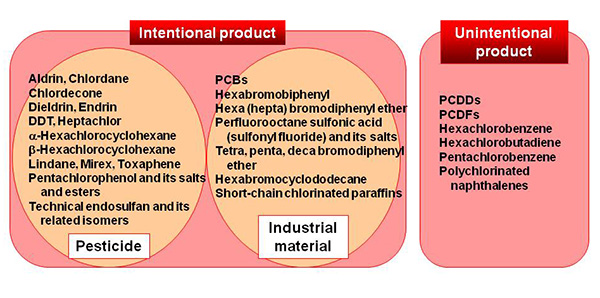
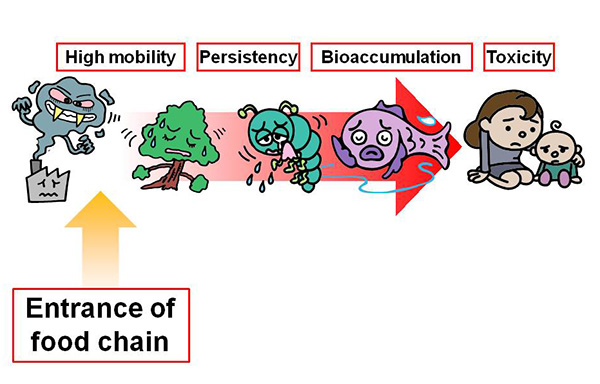
(1) Elucidation of degradation mechanisms of contaminants by drug-metabolizing enzymes and its application
Animals ingest various kinds of foreign compounds into the body through contaminated food. Occasionally, the accumulation of these compounds causes serious toxicity to the animals and affects not only the present generation, but also the next generation. To avoid this adverse effect, animals have a sophisticated detoxification system. Foreign compounds that enter the cell are acted upon by the metabolic enzymes called cytochrome P450 (P450, CYP) monooxygenases, which increases the solubility of the compounds in water and makes them more susceptible to subsequent metabolic reactions. As a result, the foreign compounds are easily excreted from the body, thereby reducing their toxicity.
Our research is investigating P450 monooxygenases, particularly the action of mammalian P450 monooxygenases on POPs. This will help to estimate the susceptibility of animals to pollutants, characterize animals that are easily affected by the toxicity of POPs and those that are not. For example, it was revealed that one of the POPs, CB126 (3,3′,4,4′,5-pentachlorobiphenyl), which has the highest dioxin-like toxicity among 209 kinds of PCBs, was metabolized into two kinds of hydroxylated metabolites by CYP1A1 derived from rats. Hydroxylated metabolites are more soluble in water than the original CB126, which makes them susceptible to reactions with other metabolic enzymes and increases the possibility of their excretion from the body. Therefore, the toxicity of CB126 is speculated to decrease. In contrast, though human CYP1A1 shows identity in an amino acid sequence (79%) with rat CYP1A1, it cannot metabolize CB126. In conclusion, the toxicity of CB126 in humans is considered to be higher than in rats.
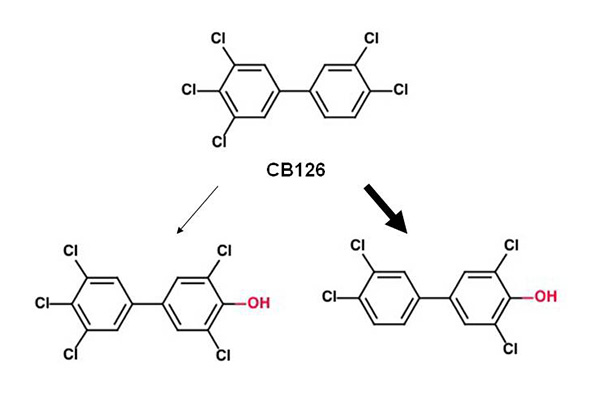
Furthermore, using the three dimensional structural models of P450, we clarified the difference in PCB metabolic activity, which varies depending on the animals. It was revealed that the difference in metabolic activity towards CB126 between rat and human CYP1A1 is due to the fact that two out of about 500 amino acids constituting CYP1A1 are different. These two amino acids were found to be located in the substrate-binding cavity of CYP1A1 to which CB126 binds, and were observed to be important for the latter’s arrangement to be sensitive to reaction. In other words, it can be said that these two amino acids determine the difference in metabolism of CB126 in humans and rats. Focusing on these two amino acids, we may be able to deduce animals that are susceptible to PCB toxicity.
Enormous kinds of microorganisms are living in the environment. Like animals, microorganisms also have P450 monooxygenases which are responsible for the metabolism of foreign compounds and the biosynthesis of biologically important substances. P450BM3, a P450 monooxygenase of the soil bacterium Bacillus megaterium, shows the highest activity among all P450s, does not bind to the endoplasmic reticulum membrane and exhibits a rare characteristic of being soluble. For this reason, protein purification, analysis of tertiary structure, and the creation of mutants have imparted new enzyme activities. With this as the focal point and utilizing the three-dimensional structure, we are doing research to create a P450BM3 which can efficiently metabolize POPs by amino acid mutation that is important for the binding of POPs. If such a P450BM3 that metabolizes POPs is prepared, it can be applied for environmental remediation.
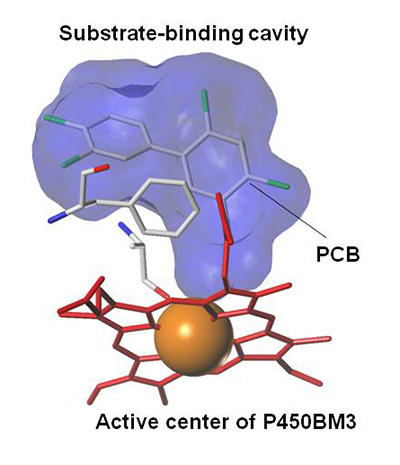
(2) Elucidation and application of the mechanisms that govern crop contamination by pollutants
Plants absorb water and nutrients necessary for growth, from the soil through the roots and supply them to the whole body. However, the plants does not selectively absorb the positive growth factors. If pollutants are present in the soil near the roots, they will be inevitably absorbed. Therefore, it is important to cultivate in a field with low contamination to obtain safe crops. Generally, highly bioaccumulative pollutants such as POPs which are fat-soluble, are taken up and accumulated in the roots, but are hardly transported to the upper parts of the plants. Therefore, it does not translocate, accumulate and contaminate the aerial fruit of the crops. On the other hand, Cucurbitaceae crops such as cucumber, pumpkin, and zucchini accumulate POPs in their leaves, stems and fruits at a higher concentration as compared to other plant species. In Japan, POPs that were used more than 40 years ago and are now banned, have been detected in cucumber and pumpkin fruits, exceeding the residue limit. The concentration of POPs ingested by people through Cucurbitaceae crops may not exert adverse effects immediately on the health of consumers. However, collection and disposal of crops exceeding the residue limit from the market, and reputation damages are a heavy burden for farmers cultivating these crops. So why does such a pollution occur only while cultivating Cucurbitaceae crops?
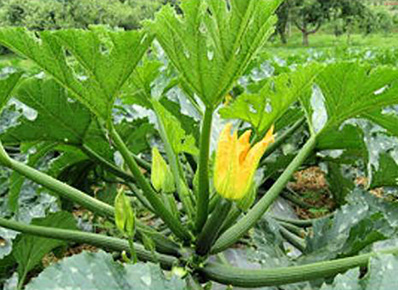
In order to elucidate this mystery, we focused on the uptake of pollutants by root cells and its transport to the aerial parts in Cucurbitaceae plants. Pollutants, especially POPs targeted by us, are strongly bound to organic matter in soil because they have properties that show low solubility in water. Analogous to the usage of inorganic nutrients by plants, POPs combined with soil are dissolved in water and taken up by the roots. Due to the high ability of Cucurbitaceae crops to take up and accumulate pollutants in the roots, contamination of the fruits above the ground is also a possibility. To contradict this notion, live roots were observed with the aid of a microscope for the uptake of contaminants into the roots. It was confirmed that Cucurbitaceae and even non-Cucurbitaceae plants had the same extent of accumulation, but contaminants were accumulated in the cells close to the center of the root. Until now, it was presumed that chemical substances that are difficult to dissolve in water, are adsorbed to the surface of the roots and do not move to the center of the root. Though it was not possible to find the difference of contamination in fruits between the Cucurbitaceae and the non-Cucurbitaceae plants, this became a new discovery.
The next assumption was the existence of a difference in the transport from the roots to the aerial parts. Water and nutrients taken up from the roots are transported by a liquid called a xylem sap, which exudes out on cutting the stem. "Loofa water" which has been used as a skin lotion from the past, is a xylem sap collected from loofah. As POPs are hardly soluble in water, it was speculated that they are dissolved in the xylem sap and transported. From the several experiments conducted, we concluded that the mechanism is due to the binding of POPs and proteins contained in the xylem sap. The major latex-like protein (MLP) contained in the xylem sap is bound to the POPs to dissolve them and transport from the roots to the aerial parts along with the flow of the sap. It is important for crop contamination by POPs that MLPs are in the roots and move to the aerial parts via xylem sap.
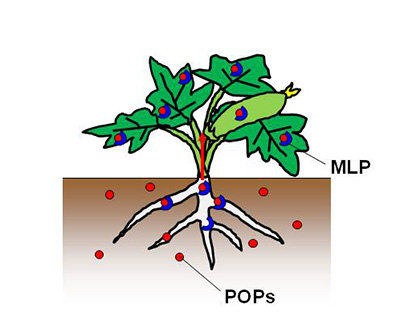
From our research results, we analyzed that the MLPs can be changed so as to not bind pollutants, or their concentration contained in roots and xylem sap can be reduced, thereby preventing contamination of cucumber and zucchini fruits by POPs. This will lead to safe food production. On the contrary, if we overproduce MLPs in plants, we can create environment-remediating plants that can efficiently accumulate pollutants. The method of environmental remediation using plants is called phytoremediation which can be used to effectively concentrate low-concentration pollutants into plants by utilizing the roots spread in the soil.




